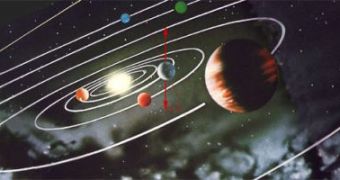What would happen to our planet if a large volcano would start to grow somewhere far above or below the equator? According to a theory dubbed the 'true polar wander' theory, the Earth would tilt to keep its balance. And now Princeton scientists have found the first compelling evidences that such tilting has actually occurred in the past - and might occur again.
The theory states that if an unequal distribution of weight ever developed in the interior or on the surface of the planet, the planet's rotation would eventually re-balance it. For example the Earth would tilt so that the hypothetical large volcano far away from the equator would eventually be relocated to a point along the equator.
Princeton University's Adam Maloof, an assistant professor of geosciences, has analyzed the magnetic composition of ancient sediments found in the remote Norwegian archipelago of Svalbard and concluded that "a true polar wander event happened about 800 million years ago." This is the first strong evidence in favor of the true wanderer theory.
"If we can find good corroborating evidence from other parts of the world as well, we will have a very good idea that our planet is capable of this sort of dramatic change," Maloof said.
The true wanderer theory was first stated in the mid-19th century but it was relatively eclipsed by the discovery of the continental drift - the movement of individual continents relative to one another across the Earth's surface under the influence of plate tectonics.
"Planetary scientists still talk about polar wander for other worlds, such as Mars, where a massive buildup of volcanic rock called Tharsis sits at the Martian equator," Maloof said. "But because Earth's surface is constantly changing as the continents move and ocean crustal plates slide over and under one another, it's more difficult to find evidence of our planet twisting hundreds of millions of years ago, as Mars likely did while it was still geologically active."
However, the sediments that the team studied in Svalbard from 1999 to 2005 may have provided just such long-sought evidence. When rock particles sink to the ocean floor to form layers of new sediment, tiny magnetic grains within the particles align themselves with the magnetic lines of the Earth. Once this rock hardens, it becomes a reliable record of the direction the Earth's magnetic field was pointing at the time of the rock's formation. So, if a rock has been spun around by a dramatic geological event, its magnetic field will have an apparently anomalous orientation that geophysicists like those on Maloof's team seek to explain.
"We found just such anomalies in the Svalbard sediments," Maloof said. "We made every effort to find another reason for the anomalies, such as a rapid rotation of the individual crustal plate the islands rest upon, but none of the alternatives makes as much sense as a true polar wander event when taken in the context of geochemical and sea level data from the same rocks."
The findings, he said, could possibly explain odd changes in ocean chemistry that occurred about 800 million years ago. Other similar changes in the ocean have cropped up in ancient times but at these other times scientists know that an ice age was to blame.
"Scientists have found no evidence for an ice age occurring 800 million years ago, and the change in the ocean at this juncture remains one of the great mysteries in the ancient history of our planet," he said. "But if all the continents were suddenly flipped around and their rivers began carrying water and nutrients into the tropics instead of the Arctic, for example, it could produce the mysterious geochemical changes science has been trying to explain."
The team obtained all its data from the islands of Svalbard and in order to have more confidence that their interpretation is valid they plan to seek corroborating evidence within sediments of similar age from elsewhere on the planet. Maloof said they spotted a place in Australia that looks promising.
"We cannot be certain of these findings until we find similar patterns in rock chemistry and magnetics on other continents," Maloof said. "Rocks of the same age are preserved in the Australian interior, so we'll be visiting the site over the next two years to look for additional evidence. If we find some, we'll be far more confident about this theory's validity."
Maloof said that true polar wander was most likely to occur when the Earth's landmasses were fused together to form a single supercontinent, something that has happened at least twice in the distant past. However, "we don't expect there to be another event in the foreseeable future, though," he said. "The Earth's surface is pretty well balanced today."

 14 DAY TRIAL //
14 DAY TRIAL //